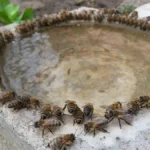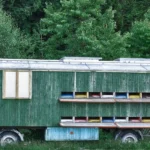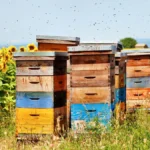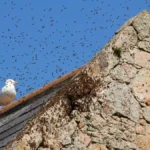How far do honey bees travel from the hive? In this article, we will take a look at the foraging radius of a beehive. Bees collect a number of different things from nature, and the distance they fly for each varies.
The Economics Of Flying
A bee, like any creature or machine, incurs wear and tear with increasing activity. Bees have a limited distance they can fly in their lives, and the further they fly to forage, the faster they wear out. In this regard, we will look at the maximum distance bees can fly, but also the economically optimal distance.
How Far Do Honey Bees Travel From The Hive?
There are various reports on this distance with perhaps the most optimistic of those being 7.5 miles. Von Frisch is a somewhat controversial scientist and in more recent years other researchers have recorded foraging ranges somewhat less extreme than those in the 4-5 mile range. This varies from the race of bees to the race of bees and even the time of year.
I have moved bees 4 miles to a new apiary, and in the morning I had a lot of bees returning to the old location. This would suggest rather strongly that they definitely do not get lost over a 4-mile range.
Again, we must return to the economics – bees may be able to travel the optimistic distances Von Frisch suggested – but should they? They have a limited distance they can fly in their life, and if they are flying 7.5 miles to a flower and 7.5 miles back they will wear out very fast.
Read more about: Do Honey Bees Migrate?
How Far Will Bees Fly For Propolis?
This appears to be an unanswered question. I have however witnessed bees collecting propolis in very arid regions where few natural hives are present. The propolis was being collected at a range of 8 or so miles from the apiary. This will be a question we can answer properly in a few years as the technologies for tracking bees get miniaturized more and more.
How Far Do Bees Travel For Water?
Bees will fly up to 5 miles to fetch water, but this places the bees under stress. Typically, we try to ensure bees have adequate water sources within 50-100 yards of the apiary. Much like a vehicle, we try to conserve our bees by using them as little as possible. They also take a while to find water at greater distances from the hive, and this can place them under stress.
I have spoken to researchers who have worked in the Kalahari desert and some suggested bees may be able to travel even further than Von Frisch’s somewhat optimistic measurements. This is however under duress.
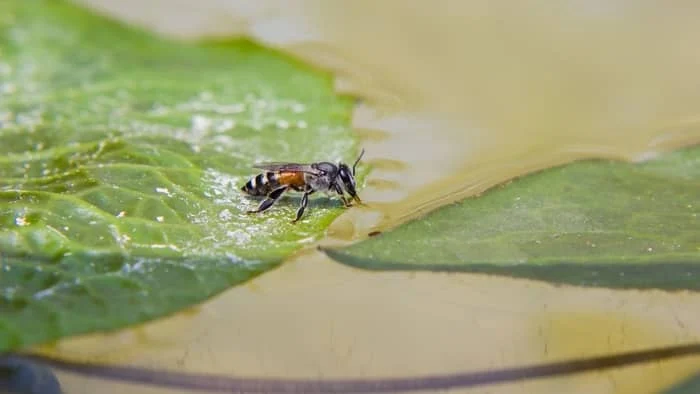
How Far Do Bees Travel In Their Life?
This appears to be one of those very difficult questions to answer. The reason for this is that a bee’s health and nutritional status will to a certain extent determine how far it can travel in its life. I have worked with people such as Professor Randal Hepburn who felt that bees can travel about 500 to 650 miles in their life. I have seen other reports that suggest a bit more or a bit less. But let us work on this as a safe distance they can fly.
Why Placing Bees Close To Nectar Is Important
If we work on a bee being able to travel 500-650 miles in its life we can maximize production by placing hives close to nectar. `This means the bees have to fly 100 yards to a field and 100 yards back they can get 4400 trips in their life. If however, they are flying 5 miles, then they get a rather paltry 250 trips in their life. This makes a very big difference to the profitability of your beehive.
If we want to maximize hive honey production, placing the apiary so that the minimum foraging distance is flown is very important. As with any extractive industry, the profitable operating range of a resource is important. If we were to use an analogy, Gold is very valuable and very compact – we can mine that anywhere on Earth and transport it anywhere else and make money. Sand on the other hand is less valuable, and we typically try to source that as close to a building site as possible.
In this regard, bees will fly great distances to visit a profitable nectar resource, and very short distances to visit a poor nectar resource. I once knew an apple farmer who went to his neighbor 6 miles away and purchased a forest of Eucalyptus trees from him. And cut them down. The poor guy was paying a fortune to rent bees for apple pollination, and the bees flew over the apple orchards to the Eucalyptus forest far away. They preferred this nectar to apple nectar. After he cut the forest down, his apple crop increased by a factor of 4 as he achieved proper pollination.
Bee Nutrition and Optimal Flying Range
A honey bee is a complex animal as are all animals. If a bee is well nourished and receives a good protein diet when it grows, its muscles and wings will be of a higher quality than that of a malnourished bee. The presence or absence of disease in bees will also determine how far they can fly. Healthy, well-fed bees are just able to fly further. This is similar to a well-funded sportsperson who receives optimal food, versus a person who is trying to break into the sports arena from a poor background. The person from a well-funded background has a head start.
In this regard, placing your bees in an area where they have a diverse pollen diet also helps provide flying range extension. Diverse pollen has diverse amino acid composition. This is why meadows and similar diverse natural forage areas are important in addition to commercial crops.
How far do honey bees travel from the hive? Well now we know – it is a sort of variable flexible answer! But they travel very far, and very fast, and the better fed they are they fly further and faster! If you enjoyed it, please share.

Dr. Garth A. Cambray is a Canadian/South African entrepreneur and beekeeper with 28 years of experience in apiculture and specializes in adding value to honey. His Ph.D. research developed a new advanced continuous fermentation method for making mead that has resulted in a number of companies globally being able to access markets for mead. His company, Makana Meadery, exports honey mead to the USA where it is available to discerning connoisseurs. He has also developed technologies to commercially manufacture organic honey vinegar in Zambia for export globally. He holds a few patents globally in the ethanol industry and believes in technology and knowledge transfer for human development and environmental sustainability. One of his proudest achievements is the fact that the wind farm he started at one of his old apiary sites has essentially made his hometown carbon neutral.

